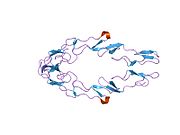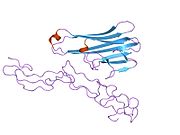Tumor necrosis factor receptor 1
Template:PBB Tumor necrosis factor receptor superfamily member 1A is a protein that in humans is encoded by the TNFRSF1A gene.[1][2] The protein encoded by this gene is a member of the Tumor necrosis factor receptor superfamily, which also contains TNFRSF1B. This protein is one of the major receptors for the tumor necrosis factor-alpha. This receptor can activate the transcription factor NF-κB, mediate apoptosis, and function as a regulator of inflammation. Antiapoptotic protein BCL2-associated athanogene 4 (BAG4/SODD) and adaptor proteins TRADD and TRAF2 have been shown to interact with this receptor, and thus play regulatory roles in the signal transduction mediated by the receptor. Germline mutations of the extracellular domains of this receptor were found to be associated with the human genetic disorder called tumor necrosis factor associated periodic syndrome (TRAPS) or periodic fever syndrome.[3] Impaired receptor clearance is thought to be a mechanism of the disease.[4] Mutations in the TNFRSF1A gene is associated with elevated risk of multiple sclerosis.[5] Serum levels of TNFRSF1A are elevated in severe mental disorders.[6] [7]. High serum levels is also associated with cognitive impairment and dementia.[8][9]
Interactions
TNFRSF1A has been shown to interact with PSMD2,[10][11] FADD,[12][13] Tumor necrosis factor-alpha,[14][15] BAG4,[16][17] Janus kinase 2,[18] IKK2,[19][20] Caspase 10,[12][21] Janus kinase 1,[18][22] UBE2I,[23] TRPC4AP,[24] PIP4K2B,[25] TRAF2,[13][26][27] RIPK1,[26][28][29][30][31][32] TRADD[13][16][26][27][30][33][34] and Small ubiquitin-related modifier 1.[35][36]
See also
References
- ^ Baker E, Chen LZ, Smith CA, Callen DF, Goodwin R, Sutherland GR (1991). "Chromosomal location of the human tumor necrosis factor receptor genes". Cytogenet Cell Genet. 57 (2–3): 117–8. doi:10.1159/000133127. PMID 1655358.
{{cite journal}}: Unknown parameter|month=ignored (help)CS1 maint: multiple names: authors list (link) - ^ Schall TJ, Lewis M, Koller KJ, Lee A, Rice GC, Wong GH, Gatanaga T, Granger GA, Lentz R, Raab H; et al. (1990). "Molecular cloning and expression of a receptor for human tumor necrosis factor". Cell. 61 (2): 361–70. doi:10.1016/0092-8674(90)90816-W. PMID 2158863.
{{cite journal}}: Explicit use of et al. in:|author=(help); Unknown parameter|month=ignored (help)CS1 maint: multiple names: authors list (link) - ^ Kümpfel T, Hohlfeld R (2009). "Multiple sclerosis. TNFRSF1A, TRAPS and multiple sclerosis". Nature Reviews Neurology. 5 (10): 528–9. doi:10.1038/nrneurol.2009.154. PMID 19794511.
{{cite journal}}: Unknown parameter|month=ignored (help) - ^ "Entrez Gene: TNFRSF1A tumor necrosis factor receptor superfamily, member 1A".
- ^ "The genetic association of variants in CD6, TNFRSF1A and IRF8 to multiple sclerosis: a multicenter case-control study". PLoS ONE. 6 (4): e18813. 2011. doi:10.1371/journal.pone.0018813. PMC 3084233. PMID 21552549.
{{cite journal}}: CS1 maint: unflagged free DOI (link) - ^ Hope S, Melle I, Aukrust P, Steen NE, Birkenaes AB, Lorentzen S, et al. Similar immune profile in bipolar disorder and schizophrenia: selective increase in soluble tumor necrosis factor receptor I and von Willebrand factor. Bipolar Disorders. 2009;11:726-34.PMID:19839997
- ^ {{cite journal | pmid = 9839997
- ^ Buchhave P, Zetterberg H, Blennow K, Minthon L, Janciauskiene S, Hansson O (2010). "Soluble TNF receptors are associated with Aβ metabolism and conversion to dementia in subjects with mild cognitive impairment". Neurobiol. Aging. 31 (11): 1877–84. doi:10.1016/j.neurobiolaging.2008.10.012. PMID 19070941.
{{cite journal}}: Unknown parameter|month=ignored (help)CS1 maint: multiple names: authors list (link) - ^ Diniz BS, Teixeira AL, Ojopi EB; et al. (2010). "Higher serum sTNFR1 level predicts conversion from mild cognitive impairment to Alzheimer's disease". J. Alzheimers Dis. 22 (4): 1305–11. doi:10.3233/JAD-2010-100921. PMID 20930310.
{{cite journal}}: Explicit use of et al. in:|author=(help)CS1 maint: multiple names: authors list (link) - ^ Boldin, M P (1995). "A protein related to a proteasomal subunit binds to the intracellular domain of the p55 TNF receptor upstream to its 'death domain'". FEBS Lett. 367 (1). NETHERLANDS: 39–44. doi:10.1016/0014-5793(95)00534-G. ISSN 0014-5793. PMID 7601280.
{{cite journal}}: Unknown parameter|coauthors=ignored (|author=suggested) (help); Unknown parameter|month=ignored (help) - ^ Dunbar, J D (1997). "Two-hybrid cloning of a gene encoding TNF receptor-associated protein 2, a protein that interacts with the intracellular domain of the type 1 TNF receptor: identity with subunit 2 of the 26S protease". J. Immunol. 158 (9). UNITED STATES: 4252–9. ISSN 0022-1767. PMID 9126987.
{{cite journal}}: Unknown parameter|coauthors=ignored (|author=suggested) (help); Unknown parameter|month=ignored (help) - ^ a b Gajate, Consuelo (2005). "Cytoskeleton-mediated death receptor and ligand concentration in lipid rafts forms apoptosis-promoting clusters in cancer chemotherapy". J. Biol. Chem. 280 (12). United States: 11641–7. doi:10.1074/jbc.M411781200. ISSN 0021-9258. PMID 15659383.
{{cite journal}}: Unknown parameter|coauthors=ignored (|author=suggested) (help); Unknown parameter|month=ignored (help)CS1 maint: unflagged free DOI (link) - ^ a b c Hsu, H (1996). "TRADD-TRAF2 and TRADD-FADD interactions define two distinct TNF receptor 1 signal transduction pathways". Cell. 84 (2). UNITED STATES: 299–308. doi:10.1016/S0092-8674(00)80984-8. ISSN 0092-8674. PMID 8565075.
{{cite journal}}: Unknown parameter|coauthors=ignored (|author=suggested) (help); Unknown parameter|month=ignored (help) - ^ Bouwmeester, Tewis (2004). "A physical and functional map of the human TNF-alpha/NF-kappa B signal transduction pathway". Nat. Cell Biol. 6 (2). England: 97–105. doi:10.1038/ncb1086. ISSN 1465-7392. PMID 14743216.
{{cite journal}}: Unknown parameter|coauthors=ignored (|author=suggested) (help); Unknown parameter|month=ignored (help) - ^ Micheau, Olivier (2003). "Induction of TNF receptor I-mediated apoptosis via two sequential signaling complexes". Cell. 114 (2). United States: 181–90. doi:10.1016/S0092-8674(03)00521-X. ISSN 0092-8674. PMID 12887914.
{{cite journal}}: Unknown parameter|coauthors=ignored (|author=suggested) (help); Unknown parameter|month=ignored (help) - ^ a b Jiang, Y (1999). "Prevention of constitutive TNF receptor 1 signaling by silencer of death domains". Science. 283 (5401). UNITED STATES: 543–6. doi:10.1126/science.283.5401.543. ISSN 0036-8075. PMID 9915703.
{{cite journal}}: Unknown parameter|coauthors=ignored (|author=suggested) (help); Unknown parameter|month=ignored (help) - ^ Miki, Kiyoshi (2002). "Tumor Necrosis Factor Receptor 1 Is an ATPase Regulated by Silencer of Death Domain". Mol. Cell. Biol. 22 (8). United States: 2536–43. doi:10.1128/MCB.22.8.2536-2543.2002. ISSN 0270-7306. PMC 133739. PMID 11909948.
{{cite journal}}: Unknown parameter|coauthors=ignored (|author=suggested) (help); Unknown parameter|month=ignored (help) - ^ a b Guo, D (1998). "Induction of Jak/STAT signaling by activation of the type 1 TNF receptor". J. Immunol. 160 (6). UNITED STATES: 2742–50. ISSN 0022-1767. PMID 9510175.
{{cite journal}}: Unknown parameter|coauthors=ignored (|author=suggested) (help); Unknown parameter|month=ignored (help) - ^ Zhang, S Q (2000). "Recruitment of the IKK signalosome to the p55 TNF receptor: RIP and A20 bind to NEMO (IKKgamma) upon receptor stimulation". Immunity. 12 (3). UNITED STATES: 301–11. doi:10.1016/S1074-7613(00)80183-1. ISSN 1074-7613. PMID 10755617.
{{cite journal}}: Unknown parameter|coauthors=ignored (|author=suggested) (help); Unknown parameter|month=ignored (help) - ^ Chaudhary, P M (2000). "Activation of the NF-kappaB pathway by caspase 8 and its homologs". Oncogene. 19 (39). ENGLAND: 4451–60. doi:10.1038/sj.onc.1203812. ISSN 0950-9232. PMID 11002417.
{{cite journal}}: Unknown parameter|coauthors=ignored (|author=suggested) (help); Unknown parameter|month=ignored (help) - ^ Vincenz, C (1997). "Fas-associated death domain protein interleukin-1beta-converting enzyme 2 (FLICE2), an ICE/Ced-3 homologue, is proximally involved in CD95- and p55-mediated death signaling". J. Biol. Chem. 272 (10). UNITED STATES: 6578–83. doi:10.1074/jbc.272.10.6578. ISSN 0021-9258. PMID 9045686.
{{cite journal}}: Unknown parameter|coauthors=ignored (|author=suggested) (help); Unknown parameter|month=ignored (help)CS1 maint: unflagged free DOI (link) - ^ Miscia, Sebastiano (2002). "Tumor necrosis factor alpha (TNF-alpha) activates Jak1/Stat3-Stat5B signaling through TNFR-1 in human B cells". Cell Growth Differ. 13 (1). United States: 13–8. ISSN 1044-9523. PMID 11801527.
{{cite journal}}: Unknown parameter|coauthors=ignored (|author=suggested) (help); Unknown parameter|month=ignored (help) - ^ Saltzman, A (1998). "hUBC9 associates with MEKK1 and type I TNF-alpha receptor and stimulates NFkappaB activity". FEBS Lett. 425 (3). NETHERLANDS: 431–5. doi:10.1016/S0014-5793(98)00287-7. ISSN 0014-5793. PMID 9563508.
{{cite journal}}: Unknown parameter|coauthors=ignored (|author=suggested) (help); Unknown parameter|month=ignored (help) - ^ Soond, Surinder M (2003). "TRUSS, a Novel Tumor Necrosis Factor Receptor 1 Scaffolding Protein That Mediates Activation of the Transcription Factor NF-κB". Mol. Cell. Biol. 23 (22). United States: 8334–44. doi:10.1128/MCB.23.22.8334-8344.2003. ISSN 0270-7306. PMC 262424. PMID 14585990.
{{cite journal}}: Unknown parameter|coauthors=ignored (|author=suggested) (help); Unknown parameter|month=ignored (help) - ^ Castellino, A M (1997). "A novel interaction between the juxtamembrane region of the p55 tumor necrosis factor receptor and phosphatidylinositol-4-phosphate 5-kinase". J. Biol. Chem. 272 (9). UNITED STATES: 5861–70. doi:10.1074/jbc.272.9.5861. ISSN 0021-9258. PMID 9038203.
{{cite journal}}: Unknown parameter|coauthors=ignored (|author=suggested) (help); Unknown parameter|month=ignored (help)CS1 maint: unflagged free DOI (link) - ^ a b c Hsu, H (1996). "TNF-dependent recruitment of the protein kinase RIP to the TNF receptor-1 signaling complex". Immunity. 4 (4). UNITED STATES: 387–96. doi:10.1016/S1074-7613(00)80252-6. ISSN 1074-7613. PMID 8612133.
{{cite journal}}: Unknown parameter|coauthors=ignored (|author=suggested) (help); Unknown parameter|month=ignored (help) - ^ a b Shu, H B (1996). "The tumor necrosis factor receptor 2 signal transducers TRAF2 and c-IAP1 are components of the tumor necrosis factor receptor 1 signaling complex". Proc. Natl. Acad. Sci. U.S.A. 93 (24). UNITED STATES: 13973–8. doi:10.1073/pnas.93.24.13973. ISSN 0027-8424. PMC 19479. PMID 8943045.
{{cite journal}}: Unknown parameter|coauthors=ignored (|author=suggested) (help); Unknown parameter|month=ignored (help) - ^ Kim, J W (2000). "Activation of death-inducing signaling complex (DISC) by pro-apoptotic C-terminal fragment of RIP". Oncogene. 19 (39). ENGLAND: 4491–9. doi:10.1038/sj.onc.1203796. ISSN 0950-9232. PMID 11002422.
{{cite journal}}: Unknown parameter|coauthors=ignored (|author=suggested) (help); Unknown parameter|month=ignored (help) - ^ Duan, H (1997). "RAIDD is a new 'death' adaptor molecule". Nature. 385 (6611). ENGLAND: 86–9. doi:10.1038/385086a0. ISSN 0028-0836. PMID 8985253.
{{cite journal}}: Unknown parameter|coauthors=ignored (|author=suggested) (help); Unknown parameter|month=ignored (help) - ^ a b Blankenship, John W (2009). "Ubiquitin binding modulates IAP antagonist-stimulated proteasomal degradation of c-IAP1 and c-IAP2(1)". Biochem. J. 417 (1). England: 149–60. doi:10.1042/BJ20081885. PMID 18939944.
{{cite journal}}: Unknown parameter|coauthors=ignored (|author=suggested) (help); Unknown parameter|month=ignored (help) - ^ Newton, Kim (2008). "Ubiquitin chain editing revealed by polyubiquitin linkage-specific antibodies". Cell. 134 (4). United States: 668–78. doi:10.1016/j.cell.2008.07.039. PMID 18724939.
{{cite journal}}: Unknown parameter|coauthors=ignored (|author=suggested) (help); Unknown parameter|month=ignored (help) - ^ Varfolomeev, Eugene (2008). "c-IAP1 and c-IAP2 are critical mediators of tumor necrosis factor alpha (TNFalpha)-induced NF-kappaB activation". J. Biol. Chem. 283 (36). United States: 24295–9. doi:10.1074/jbc.C800128200. ISSN 0021-9258. PMID 18621737.
{{cite journal}}: Unknown parameter|coauthors=ignored (|author=suggested) (help); Unknown parameter|month=ignored (help)CS1 maint: unflagged free DOI (link) - ^ Schütze, S (1999). "Inhibition of receptor internalization by monodansylcadaverine selectively blocks p55 tumor necrosis factor receptor death domain signaling". J. Biol. Chem. 274 (15). UNITED STATES: 10203–12. doi:10.1074/jbc.274.15.10203. ISSN 0021-9258. PMID 10187805.
{{cite journal}}: Unknown parameter|coauthors=ignored (|author=suggested) (help); Unknown parameter|month=ignored (help)CS1 maint: unflagged free DOI (link) - ^ Pan, G (1997). "The receptor for the cytotoxic ligand TRAIL". Science. 276 (5309). UNITED STATES: 111–3. doi:10.1126/science.276.5309.111. ISSN 0036-8075. PMID 9082980.
{{cite journal}}: Unknown parameter|coauthors=ignored (|author=suggested) (help); Unknown parameter|month=ignored (help) - ^ Liou, M L (1999). "The ubiquitin-homology protein, DAP-1, associates with tumor necrosis factor receptor (p60) death domain and induces apoptosis". J. Biol. Chem. 274 (15). UNITED STATES: 10145–53. doi:10.1074/jbc.274.15.10145. ISSN 0021-9258. PMID 10187798.
{{cite journal}}: Unknown parameter|coauthors=ignored (|author=suggested) (help); Unknown parameter|month=ignored (help)CS1 maint: unflagged free DOI (link) - ^ Okura, T (1996). "Protection against Fas/APO-1- and tumor necrosis factor-mediated cell death by a novel protein, sentrin". J. Immunol. 157 (10). UNITED STATES: 4277–81. ISSN 0022-1767. PMID 8906799.
{{cite journal}}: Unknown parameter|coauthors=ignored (|author=suggested) (help); Unknown parameter|month=ignored (help)
Further reading
External links
- TNFRSF1A+protein,+human at the U.S. National Library of Medicine Medical Subject Headings (MeSH)
This article incorporates text from the United States National Library of Medicine, which is in the public domain.





